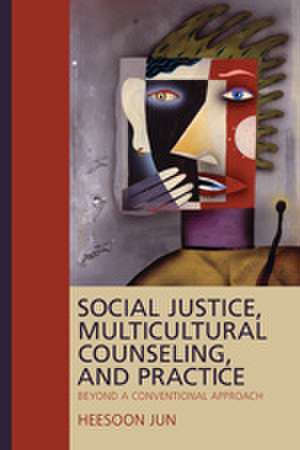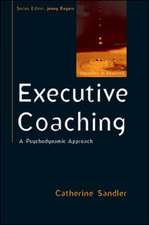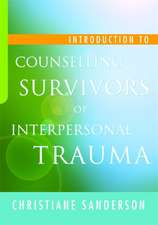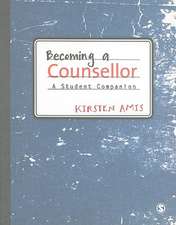Social Justice, Multicultural Counseling, and Practice: Beyond a Conventional Approach
Autor Heesoon Junen Limba Engleză Paperback – 31 aug 2009
| Toate formatele și edițiile | Preț | Express |
|---|---|---|
| Paperback (1) | 926.44 lei 6-8 săpt. | |
| SAGE Publications – 31 aug 2009 | 926.44 lei 6-8 săpt. | |
| Hardback (2) | 960.13 lei 6-8 săpt. | |
| Springer Nature Switzerland – 13 mar 2024 | 960.13 lei 6-8 săpt. | |
| SAGE Publications – 31 aug 2009 | 1279.85 lei 6-8 săpt. |
Preț: 926.44 lei
Preț vechi: 975.20 lei
-5% Nou
Puncte Express: 1390
Preț estimativ în valută:
177.28€ • 185.71$ • 146.92£
177.28€ • 185.71$ • 146.92£
Carte tipărită la comandă
Livrare economică 09-23 aprilie
Preluare comenzi: 021 569.72.76
Specificații
ISBN-13: 9781412960571
ISBN-10: 1412960576
Pagini: 488
Dimensiuni: 152 x 229 x 26 mm
Greutate: 0.64 kg
Ediția:1
Editura: SAGE Publications
Colecția Sage Publications, Inc
Locul publicării:Thousand Oaks, United States
ISBN-10: 1412960576
Pagini: 488
Dimensiuni: 152 x 229 x 26 mm
Greutate: 0.64 kg
Ediția:1
Editura: SAGE Publications
Colecția Sage Publications, Inc
Locul publicării:Thousand Oaks, United States
Cuprins
Preface
Ch 1. Introduction
The Millennium and Two Essential Ingredients
Unique Structures
Suggestions for Using the Book
Outline of the Chapters
PART I: A PRACTITIONER'S AWARENESS OF HER OWN WORLDVIEW
Ch 2. Intrapersonal Communication (Inner Dialogue)
Intrapersonal Communication and Values, Beliefs, and Biases
Intrapersonal Communication and Ethnocentrism
Ch 3. Assessment of a Practitioner's Values, Beliefs, and Biases
Barriers to an Individual's Self-Assessment of Her Own Values, Beliefs, and Biases
Awareness of Inner Experience
Self-Assessment of Values, Beliefs, and Biases
The Impact of a Practitioner's Values, Beliefs, and Biases on Assessing and Treating Clients
PART II: A PRACTITIONER'S AWARENESS OF SYSTEMATIC OPRESSION/PRIVILEGE AND INTERNALIZED OPPRESSION/PRIVILEGE
Ch 4: Racism
Race and Racism
Social Categorization Theory
Variations Within and Among Races
Racism and Racial Prejudice and Inappropriate Thinking Styles/Patterns
Strategies for and Benefits of Dismantling Racism and Racial Prejudice for Whites
A Practitioner's Assessment of Self in Relation to White Oppression/Privilege
Ch 5. Sexism
Difference Among Sex, Gender, and Sexism
Social Construction of Gender
Social Comparison Theory
Systematic Oppression/Privilege and Internalized Oppression/Privilege
The Intersection of Gender and Race
Variations Among Men, Among Women, and Between Men and Women
Sexism and Inappropriate Thinking Styles/Patterns
Strategies for and Benefits of Dismantling Sexism
A Practitioner's Assessment of Self in Relation to Sexism, Systematic Oppression/Privilege and Internalized Oppression/Privilege
Ch 6. Heterosexism
Difference Among Sexual Orientation, Homophobia, and Heterosexism
Social Construction of Heterosexism
Intersections of Race, Gender, and Sexual Orientation
Systematic Oppression/Privilege and Internalized Privilege/Oppression
Intersections of Race, Gender, and Sexual Orientation
Systematic Oppression/Privilege and Internalized Oppression/Privilege
Variations Within and Among Nonheterosexuals
Heterosexism or Homophobia and Inappropriate Thinking Styles/Patterns
Strategies for and Benefits of Dismantling Heterosexism
A Practitioner's Assessment of Self in Relation to Heterosexism, Systematic Oppression/Privilege, and Internalized Oppression/Privilege
Ch 7. Classism
A Definition of Class and Classism
Social Construction of Classism
Systematic Oppression/Privilege and Internalized Oppression/Privilege
Intersections of Race, Gender, Sexual Orientation, and Class
Variations Within and Among Classes
Classism and Inappropriate Thinking Styles/Patterns
Strategies for and Benefits of Dismantling Classism
A Practitioner's Assessment of Self in Relation to Classism, Systematic Oppression/Privilege and Internalized Oppression/Privilege
Ch 8. Ableism
Difference Between Disability and Ableism
Social Construction of Ableism
Systematic Oppression/Privilege and Internalized Oppression/Privilege
Intersections of Impairment/Disability, Race, Gender, Sexual Orientation, and Class
Variations Within and Among Individuals With Impairment/Disability
Ableism and Inappropriate Thinking Styles/Patterns
Strategies for and Benefits of Dismantling Ableism
A Practitioner's Assessment of Self in Relation to Ableism, Systematic Oppression/Privilege and Internalized Oppression/Privilege
Ch 9. Other "Isms" Due to Age, Language, Religion, and Region
Other "Isms"
Social Construction of "Isms"
Systematic Oppression/Privilege and Internalized Oppression/Privilege
Intersections of Race, Gender, Sexual Orientation, Class, Impairment/Disability, and Other Identities
Variations Within and Among Age, Language, Religion, and Region
Other "Isms" and Inappropriate Thinking Styles/Patterns
Strategies for and Benefits of Dismantling "Isms"
A Practitioner's Assessment of Self in Relation to Other "Isms", Systematic Oppression/Privilege, and Internalized Oppression/Privilege
Ch 10. Deconstructing Inappropriate Hierarchical, Dichotomous, and Linear Thinking Styles/Patterns
Reasons for Change
Deconstructing Through Transformative Learning
Internalized Oppression/Privilege and Thinking Styles/Patterns
Diligent and Mindful Practice
Transformation at the Institutional Level
PART III: A PRACTITIONER'S AWARENESS OF THE CLIENT'S WORLDVIEW
Ch 11. Identity Development
Identity Development
Models of Identity Development for Nondominant Monoracial Groups
Models of Identity Development for Biracial and Multiracial Groups
Models of Identity Development for Whites
Models of Identity Development for Gays and Lesbians
Variations Among and Within Racial Groups
Similarities and Differences Between Dominant Group and Nondominant Group Identity Development
Ch 12. Multiple Identities
Challenges of Assessing Multiple Identities
Fluidity of Identity Development
Ch 13. Culturally Appropriate Assessment
Foundations for Accurate Assessment
Assessment in Relation to Race, Gender, Sexual Orientation, Class, Disability/Impairment, Age, Language, Religion, Region, and Their Multiple Intersections
Assessment of the Intersections of Multiple Identities (Race, Gender, Class, Sexual Orientation, Impairment/Disability, Age, Language, Religion, and Region)
Rating Scales for Thinking Styles, Multiple Identities, Dominant Identities
Rating Scale for Acculturation
The Diagnostic and Statistical Manual of Mental Disorders (DSM-IV-TR) and Its Appropriateness as an Assessment Tool for Multicultural Populations
ACA, APA, and NASW Ethics Codes and Cultural Sensitivity
Ch 14. Culturally Appropriate Treatment/Healing
Culturally Appropriate Treatment
To Be a Multiculturally Competent Practitioner
Experiental Learning Through Case Studies
About the Author
Ch 1. Introduction
The Millennium and Two Essential Ingredients
Unique Structures
Suggestions for Using the Book
Outline of the Chapters
PART I: A PRACTITIONER'S AWARENESS OF HER OWN WORLDVIEW
Ch 2. Intrapersonal Communication (Inner Dialogue)
Intrapersonal Communication and Values, Beliefs, and Biases
Intrapersonal Communication and Ethnocentrism
Ch 3. Assessment of a Practitioner's Values, Beliefs, and Biases
Barriers to an Individual's Self-Assessment of Her Own Values, Beliefs, and Biases
Awareness of Inner Experience
Self-Assessment of Values, Beliefs, and Biases
The Impact of a Practitioner's Values, Beliefs, and Biases on Assessing and Treating Clients
PART II: A PRACTITIONER'S AWARENESS OF SYSTEMATIC OPRESSION/PRIVILEGE AND INTERNALIZED OPPRESSION/PRIVILEGE
Ch 4: Racism
Race and Racism
Social Categorization Theory
Variations Within and Among Races
Racism and Racial Prejudice and Inappropriate Thinking Styles/Patterns
Strategies for and Benefits of Dismantling Racism and Racial Prejudice for Whites
A Practitioner's Assessment of Self in Relation to White Oppression/Privilege
Ch 5. Sexism
Difference Among Sex, Gender, and Sexism
Social Construction of Gender
Social Comparison Theory
Systematic Oppression/Privilege and Internalized Oppression/Privilege
The Intersection of Gender and Race
Variations Among Men, Among Women, and Between Men and Women
Sexism and Inappropriate Thinking Styles/Patterns
Strategies for and Benefits of Dismantling Sexism
A Practitioner's Assessment of Self in Relation to Sexism, Systematic Oppression/Privilege and Internalized Oppression/Privilege
Ch 6. Heterosexism
Difference Among Sexual Orientation, Homophobia, and Heterosexism
Social Construction of Heterosexism
Intersections of Race, Gender, and Sexual Orientation
Systematic Oppression/Privilege and Internalized Privilege/Oppression
Intersections of Race, Gender, and Sexual Orientation
Systematic Oppression/Privilege and Internalized Oppression/Privilege
Variations Within and Among Nonheterosexuals
Heterosexism or Homophobia and Inappropriate Thinking Styles/Patterns
Strategies for and Benefits of Dismantling Heterosexism
A Practitioner's Assessment of Self in Relation to Heterosexism, Systematic Oppression/Privilege, and Internalized Oppression/Privilege
Ch 7. Classism
A Definition of Class and Classism
Social Construction of Classism
Systematic Oppression/Privilege and Internalized Oppression/Privilege
Intersections of Race, Gender, Sexual Orientation, and Class
Variations Within and Among Classes
Classism and Inappropriate Thinking Styles/Patterns
Strategies for and Benefits of Dismantling Classism
A Practitioner's Assessment of Self in Relation to Classism, Systematic Oppression/Privilege and Internalized Oppression/Privilege
Ch 8. Ableism
Difference Between Disability and Ableism
Social Construction of Ableism
Systematic Oppression/Privilege and Internalized Oppression/Privilege
Intersections of Impairment/Disability, Race, Gender, Sexual Orientation, and Class
Variations Within and Among Individuals With Impairment/Disability
Ableism and Inappropriate Thinking Styles/Patterns
Strategies for and Benefits of Dismantling Ableism
A Practitioner's Assessment of Self in Relation to Ableism, Systematic Oppression/Privilege and Internalized Oppression/Privilege
Ch 9. Other "Isms" Due to Age, Language, Religion, and Region
Other "Isms"
Social Construction of "Isms"
Systematic Oppression/Privilege and Internalized Oppression/Privilege
Intersections of Race, Gender, Sexual Orientation, Class, Impairment/Disability, and Other Identities
Variations Within and Among Age, Language, Religion, and Region
Other "Isms" and Inappropriate Thinking Styles/Patterns
Strategies for and Benefits of Dismantling "Isms"
A Practitioner's Assessment of Self in Relation to Other "Isms", Systematic Oppression/Privilege, and Internalized Oppression/Privilege
Ch 10. Deconstructing Inappropriate Hierarchical, Dichotomous, and Linear Thinking Styles/Patterns
Reasons for Change
Deconstructing Through Transformative Learning
Internalized Oppression/Privilege and Thinking Styles/Patterns
Diligent and Mindful Practice
Transformation at the Institutional Level
PART III: A PRACTITIONER'S AWARENESS OF THE CLIENT'S WORLDVIEW
Ch 11. Identity Development
Identity Development
Models of Identity Development for Nondominant Monoracial Groups
Models of Identity Development for Biracial and Multiracial Groups
Models of Identity Development for Whites
Models of Identity Development for Gays and Lesbians
Variations Among and Within Racial Groups
Similarities and Differences Between Dominant Group and Nondominant Group Identity Development
Ch 12. Multiple Identities
Challenges of Assessing Multiple Identities
Fluidity of Identity Development
Ch 13. Culturally Appropriate Assessment
Foundations for Accurate Assessment
Assessment in Relation to Race, Gender, Sexual Orientation, Class, Disability/Impairment, Age, Language, Religion, Region, and Their Multiple Intersections
Assessment of the Intersections of Multiple Identities (Race, Gender, Class, Sexual Orientation, Impairment/Disability, Age, Language, Religion, and Region)
Rating Scales for Thinking Styles, Multiple Identities, Dominant Identities
Rating Scale for Acculturation
The Diagnostic and Statistical Manual of Mental Disorders (DSM-IV-TR) and Its Appropriateness as an Assessment Tool for Multicultural Populations
ACA, APA, and NASW Ethics Codes and Cultural Sensitivity
Ch 14. Culturally Appropriate Treatment/Healing
Culturally Appropriate Treatment
To Be a Multiculturally Competent Practitioner
Experiental Learning Through Case Studies
About the Author
Notă biografică
Dr. Heesoon Jun has a Mater¿s degree in psychology from Radford University in Virginia and a Ph.D. in psychology from the University of Washington in Washington. Currently ,she resides in Washington State where she is a licensed psychologist with a part-time private practice and teaches psychology at Evergreen State College including multicultural counseling.
Dr. Jun was born and raised by a religiously tolerant but race/class biased family in Seoul, South Korea. She came to the United States alone to study psychology as an undergraduate where she experienced her status change from the majority to the minority, and privileged to oppressed. Dr. Jun¿s bicultural and bilingual experiences have been instrumental in facilitating an interest in, (a) the impact of sociocultural contexts on one¿s own values, beliefs, and automatic thoughts; and (b) how to implement social justice and equity for diversified populations.
Dr. Jun was born and raised by a religiously tolerant but race/class biased family in Seoul, South Korea. She came to the United States alone to study psychology as an undergraduate where she experienced her status change from the majority to the minority, and privileged to oppressed. Dr. Jun¿s bicultural and bilingual experiences have been instrumental in facilitating an interest in, (a) the impact of sociocultural contexts on one¿s own values, beliefs, and automatic thoughts; and (b) how to implement social justice and equity for diversified populations.
Descriere
A challenging book that will help students on counselling courses think about different approaches to race and diversity
Textul de pe ultima copertă
This third edition book offers a paradigm shift in thinking (from binary to complex) and enables visibility for the intersectionality of multiple identities that range from privileged to oppressed. For example, real people’s heterogeneous racial identities within the same racial group are visible. A paradigm shift in learning (from conceptual to transformative) connects conceptual learning (cognition) to their experience (affect). “…. transformation does not simply emerge due to the individual’s awareness…. but is experienced” (Benetka & Joerchel, 2016, p. 22). Uncensored first-person (subjective) written responses to specific questions to access unconscious and implicit bias will connect the writer’s experience to conceptual learning of diversity, equity, and inclusion. Writing in third person (objective) interrupts the transformative aspect by bypassing the accessibility of inner experience. Writing in first-person connects the writer to their experience which allows the unconscious to be accessed if it is practiced on a regular basis.
This book is for everyone who wants to implement diversity, equity, and inclusion measures by learning to access their unconscious bias. Understanding social justice and equity and good intentions alone do not lead to accessing unconscious bias.
This book is for everyone who wants to implement diversity, equity, and inclusion measures by learning to access their unconscious bias. Understanding social justice and equity and good intentions alone do not lead to accessing unconscious bias.
Caracteristici
Uncensored first-person writing leads readers to be aware of their inner experiences (e.g., unconscious biases) Incorporate scientific inquiry with clinical inquiry for accurate assessment, diagnosis, and effective treatment Considers multiple perspectives from the client to care provider to implicit biases











